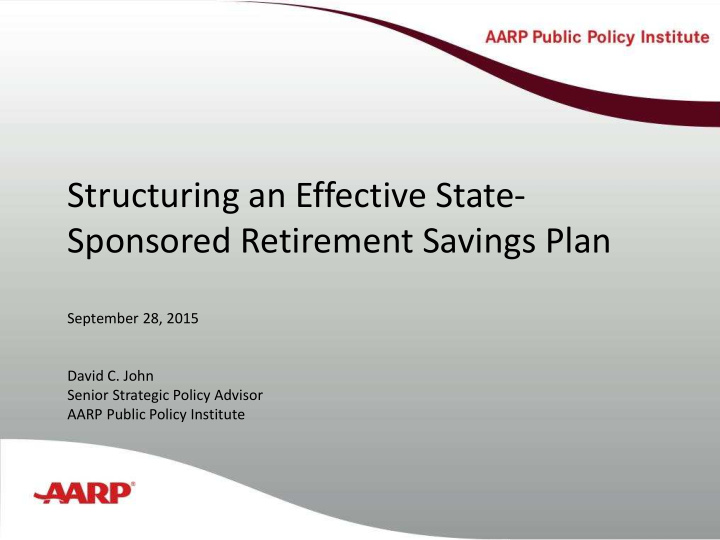



Title text here Structuring an Effective State- Sponsored Retirement Savings Plan September 28, 2015 David C. John Senior Strategic Policy Advisor AARP Public Policy Institute
US Workers Like Auto Enrollment • Auto enrollment made saving easy: 95% • I started retirement saving earlier: 85% • Satisfied with process (enrolled): 97% • Satisfied with process (opted out): 90% • Glad my company offers (enrolled): 98% • Glad my company offers (opted out): 79% – RMS poll 2007
Auto vs. Mandatory: Results • UK Large Employers: 91% coverage (DWP 8/13 range 85%-95%) • US: 92% new employees (Fidelity) 85% new and existing (numerous cites) • New Zealand: About 75%; Only 55% Contributing (8/13 NZ Financial Services Council) • Australia Coverage: 87% - 98% of employees (Australian Bureau of Statistics)
Start Simply • When implementing a state-sponsored plan, it is better to start with a simple plan that works than with a complex plan that does not: • While there could be a temptation to solve every retirement savings problem at once, it is far better to start with a very simple plan that works and is understandable to both employers and employees, and then add features to it over time.
Make it Compatible • As most US workers have a number of jobs during their working life, state-sponsored plans should ensure that their accounts are compatible with those offered through private sector employers. • It is extremely likely that a significant proportion of plan participants will end up transferring their money to another plan sponsored by a new employer and that other participants will transfer money into the state plan.
Low risk for new savers? • The United Kingdom’s National Employment Savings Trust (NEST) investment platform places the contributions of new savers in a riskless stable value fund for the first two years after they join the fund. This protects savers from becoming discouraged from continuing after losing money as they start to save. • After the initial two years, NEST moves their money to the appropriate target date fund for savers of their age and places all new contributions into that fund instead.
Guarantees • While guarantees are simple in concept, they are highly complex in practice. • Someone must be prepared to cover the costs, whether it is the saver, the plan sponsor or the taxpayer. • There are two different measures of cost that are often confused. One measures effect on a government budget, while the other reflects the actual cost to a saver, insurer or government that includes the opportunity cost of a guarantee. Using the wrong measurement can produce overly optimistic low cost estimates.
Consumer Protections • Explicit consumer protections will help to build confidence in the state-sponsored plan and to encourage participation. • Appropriately structured state consumer protections could provide the same level of protection as ERISA or even greater protection. • Policymakers do need to balance the desire for explicit protections with the need to keep the plan simple and to limit the requirements placed on employers.
Retirement Income Illustrations • Help savers to know how they are doing. • Can help to encourage additional savings. • Especially valuable if combined with a Social Security estimate.
2014 EBRI RCS Data • Useful: 85% yes, 15% no. • Amount projected: 58% as expected, 27% less, 12% more. • Will save more: 17% (35% proj. less income) • Increased saving: 69% by 10%; 24% by 25%+ • Age: 89% won’t affect age I retire. • Confidence: 20% lower confidence in ability to save. 40% of those to save more.
AARP State Retirement Savings Resource Center • Individual issue papers • Savings facts • National Policy • State Policy • Financial Literacy • http://www.aarp.org/ppi/state-retirement- plans/
Title text here Contact Us: David C. John Senior Strategic Policy Advisor djohn@aarp.org AARP Public Policy Institute www.aarp.org/ppi Twitter:@AARPpolicy www.Facebook.com/AARPpolicy Blog: www.aarp.org/policyblog
Recommend
More recommend